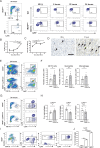MAFB in Macrophages Regulates Prostaglandin E2-Mediated Lipid Mediator Class Switch through ALOX15 in Ischemic Acute Kidney Injury
- PMID: 39230290
- PMCID: PMC11457724
- DOI: 10.4049/jimmunol.2300844
MAFB in Macrophages Regulates Prostaglandin E2-Mediated Lipid Mediator Class Switch through ALOX15 in Ischemic Acute Kidney Injury
Abstract
Monocytes and macrophages express the transcription factor MAFB (V-maf musculoaponeurotic fibrosarcoma oncogene homolog B) and protect against ischemic acute kidney injury (AKI). However, the mechanism through which MAFB alleviates AKI in macrophages remains unclear. In this study, we induced AKI in macrophage lineage-specific Mafb-deficient mice (C57BL/6J) using the ischemia-reperfusion injury model to analyze these mechanisms. Our results showed that MAFB regulates the expression of Alox15 (arachidonate 15-lipoxygenase) in macrophages during ischemic AKI. The expression of ALOX15 was significantly decreased at the mRNA and protein levels in macrophages that infiltrated the kidneys of macrophage-specific Mafb-deficient mice at 24 h after ischemia-reperfusion injury. ALOX15 promotes the resolution of inflammation under acute conditions by producing specialized proresolving mediators by oxidizing essential fatty acids. Therefore, MAFB in macrophages promotes the resolution of inflammation in ischemic AKI by regulating the expression of Alox15. Moreover, MAFB expression in macrophages is upregulated via the COX-2/PGE2/EP4 pathway in ischemic AKI. Our in vitro assay showed that MAFB regulates the expression of Alox15 under the COX-2/PGE2/EP4 pathway in macrophages. PGE2 mediates the lipid mediator (LM) class switch from inflammatory LMs to specialized proresolving mediators. Therefore, MAFB plays a key role in the PGE2-mediated LM class switch by regulating the expression of Alox15. Our study identified a previously unknown mechanism by which MAFB in macrophages alleviates ischemic AKI and provides new insights into regulating the LM class switch in acute inflammatory conditions.
Copyright © 2024 by The American Association of Immunologists, Inc.
Conflict of interest statement
The authors have no financial conflicts of interest.
Figures






References
-
- Ronco, C., Bellomo R., Kellum J. A.. 2019. Acute kidney injury. Lancet 394: 1949–1964. - PubMed
-
- Goldstein, S. L., Jaber B. L., Faubel S., Chawla L. S.; Acute Kidney Injury Advisory Group of American Society of Nephrology . 2013. AKI transition of care: a potential opportunity to detect and prevent CKD. Clin. J. Am. Soc. Nephrol. 8: 476–483. - PubMed
-
- Huen, S. C., Cantley L. G.. 2017. Macrophages in renal injury and repair. Annu. Rev. Physiol. 79: 449–469. - PubMed
-
- Cao, Q., Harris D. C. H., Wang Y.. 2015. Macrophages in kidney injury, inflammation, and fibrosis. Physiology (Bethesda) 30: 183–194. - PubMed
MeSH terms
Substances
Grants and funding
LinkOut - more resources
Full Text Sources
Research Materials

